Physical Address
304 North Cardinal St.
Dorchester Center, MA 02124
Airway problems in head and neck (H&N) patients are common, and so are the airway failures. The anesthesia provider must develop and maintain excellent dexterity with a wide range of airway management devices and techniques.
The preoperative endoscopic airway examination (PEAE) should become an integral part of the H&N anesthesia provider’s armamentarium.
In patients with compromised airway, awake or asleep flexible scope intubation (FSI) or video-assisted laryngoscopy (VAL) should substitute for direct laryngoscopy (DL) as a primary approach to tracheal intubation (TI), whenever feasible.
High-risk H&N patients demand thorough preoperative preparation, discussion with the surgeon, and development of joint, well-thought-through airway management strategies.
A structured and stepwise approach to a tenuous and partially obstructed airway is imperative for successful management.
The advanced ventilation techniques, such as transnasal humidified rapid-insufflation ventilatory exchange (THRIVE), SponTaneous Respiration using IntraVEnous anaesthesia and Hi-flow nasal oxygen (STRIVE Hi), and the Tritube are being developed and are effective in selected patient populations, particularly in those with the partially obstructed airway. The use of these techniques requiring specialized expertise and teamwork in a shared airway setting.
The principles and practice of jet ventilation (JV) must be well understood and adhered to by the anesthesia provider and the surgeon.
For laser surgery, the fire triangle (fire triad) must be well understood and managed by all members of the team. The airway fire requires three components: fuel source, oxidant sources, and ignition source. Removal of one of these components prevents or reduces the risk. Adherence to the laser timeouts and the institutional laser safety protocols must be required.
Close communication between the anesthesia provider and the surgeon throughout the perioperative period is critical for the success of the operation and for patient safety.
Airway management in head and neck (H&N) surgery presents some unique challenges for the anesthesia provider ( Box 38.1) . The difficult airway (DA) is observed more frequently in H&N patients than in the general surgical population. In the Fourth National Audit Project (NAP4), H&N patients comprised nearly 40% of cases with airway management–related complications and almost 75% of cases where an emergent surgical airway was required for the cannot intubate/cannot oxygenate (CICO) situation. , Several large studies have demonstrated that difficult tracheal intubation (TI) (≥3 attempts on direct laryngoscopy) may be encountered in 7% to 9% of H&N cases, which is at least two to four times higher than in the mixed surgical population. H&N cancer patients, predominantly males, are at even higher risk: Difficult direct laryngoscopy (DL) and TI can be observed in over 12% of these patients. Bryan and colleagues have observed that patients with oropharyngeal masses present at particularly high risk for difficult TI and associated hypoxemia: 23% of these patients required ≥3 intubation attempts, 68% were difficult to mask ventilate, and in 34% Spo 2 was below 95% during the procedure. Moreover, tracheal extubation and early recovery period present increased challenges to the anesthesia provider. ,
Increased risk of difficult and emergent airway management
Extubation challenges
Team-centered approach
Shared airway with the surgeon
Surgery-specific airway management requirements
The team-centered approach to an anticipated DA in H&N surgery is paramount. Successful airway management of H&N patients requires a high degree of cooperation with the surgeon, allowing for early identification of high-risk patients, a reciprocal understanding of the potential management problems, and adequate preparation on both sides to meet the anticipated challenges that may arise. , Thorough appreciation of the complexity of the upper airway anatomy, the pathologic process involved, and all steps of the surgical procedure are necessary for devising a safe and rational perioperative airway management strategy. Special expertise in H&N anesthesia and complex airway management should be encouraged because it may improve TI outcomes and result in quicker intubation times, better patient oxygenation, and fewer failures.
Competent sharing of the patient’s airway with the surgeon greatly contributes to safe patient management. Most of the time, not only is the patient’s airway shared with the surgeon, but immediate access to the airway is also difficult or impossible, because the operating room (OR) table is turned 90 or 180 degrees away from the anesthesia provider. The endotracheal tube (ETT) must be secured diligently to prevent an accidental extubation under the surgical drapes or a withdrawal of the ETT into the larynx; a sudden air leak may negatively affect the surgical field during precision surgery and create an airway fire hazard during intraoral procedures. Unrecognized ETT displacement out of the trachea and into the glottis carries an additional risk for the anesthesia provider to repeatedly add more air to the ETT cuff, which may lead to the compression of the anterior branch of the recurrent laryngeal nerve and vocal cord (VC) injury. During oral and intranasal surgery, the patient’s airway must be protected from blood, debris, and irrigation fluid, and the use of a throat pack by the surgeon may be required.
Even uncomplicated elective H&N cases require the anesthesia provider’s thorough familiarity with surgery-specific airway management requirements. The spectrum of H&N surgery is broad, ranging from the most common procedures, such as tonsillectomy, to precision laryngologic and complex obstructive sleep apnea (OSA) surgery, major H&N cancer surgery with extensive reconstructive procedures, and others. The TI route, ETT size and type, and different montages of the anesthesia circuit should all be discussed with the surgeon to streamline and optimize TI and facilitate surgical access.
For example, a nasal intubation is routinely required for base-of-the-tongue (BOT) surgical work, transoral robotic surgery (TORS), orthognathic surgery, and maxillomandibular advancement for OSA surgery, and it may be requested by the surgeon for parotidectomy and some dental procedures. A nasal ETT must be appropriately sized to ensure adequate depth of tracheal placement ( Fig. 38.1 ) and secured to prevent pressure against the alar area ( Fig. 38.2 ). A delayed-sequence nasal intubation may be considered in patients with decreased oxygen reserve or when difficult mask ventilation is encountered or anticipated ( Fig. 38.3 ).
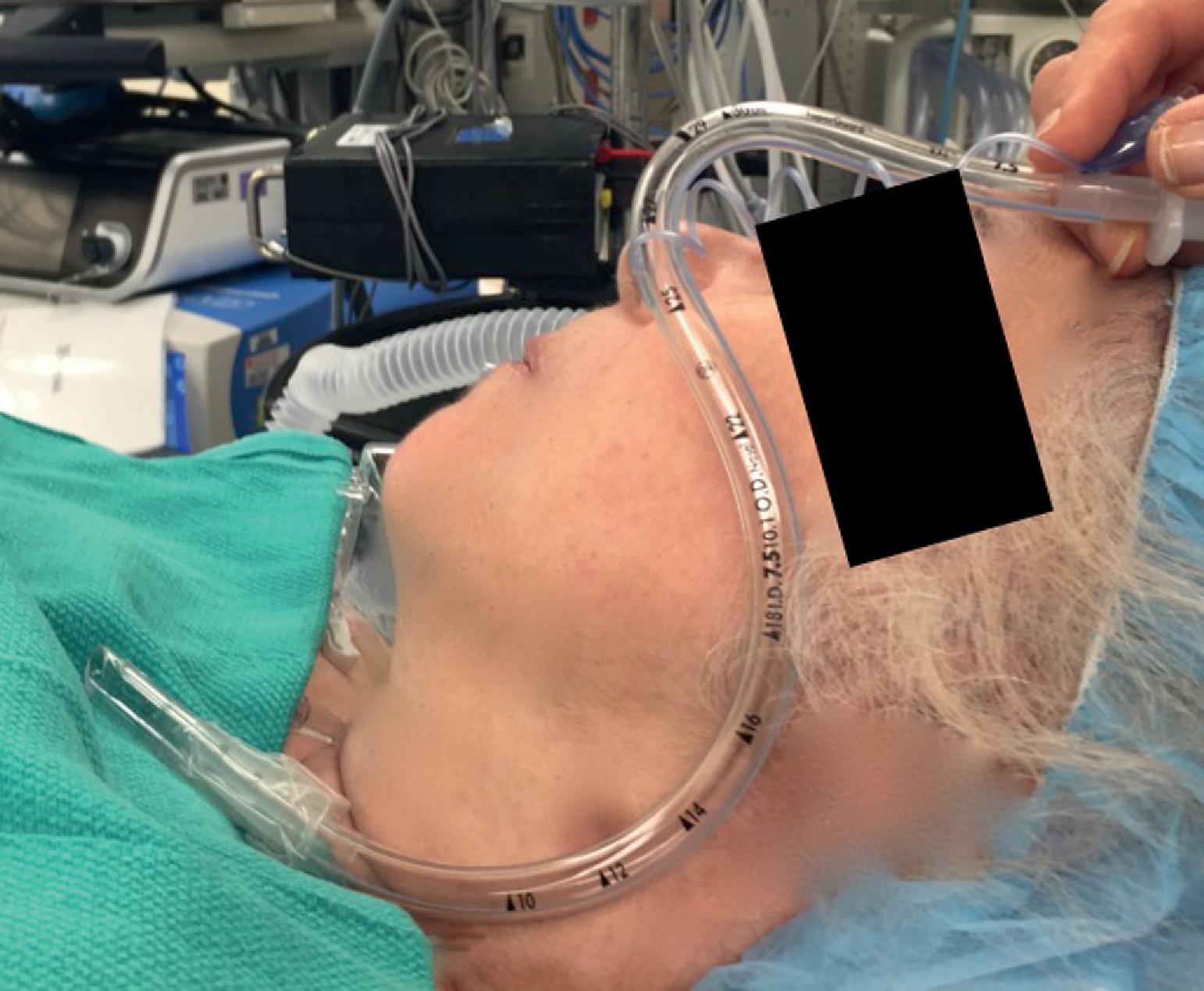
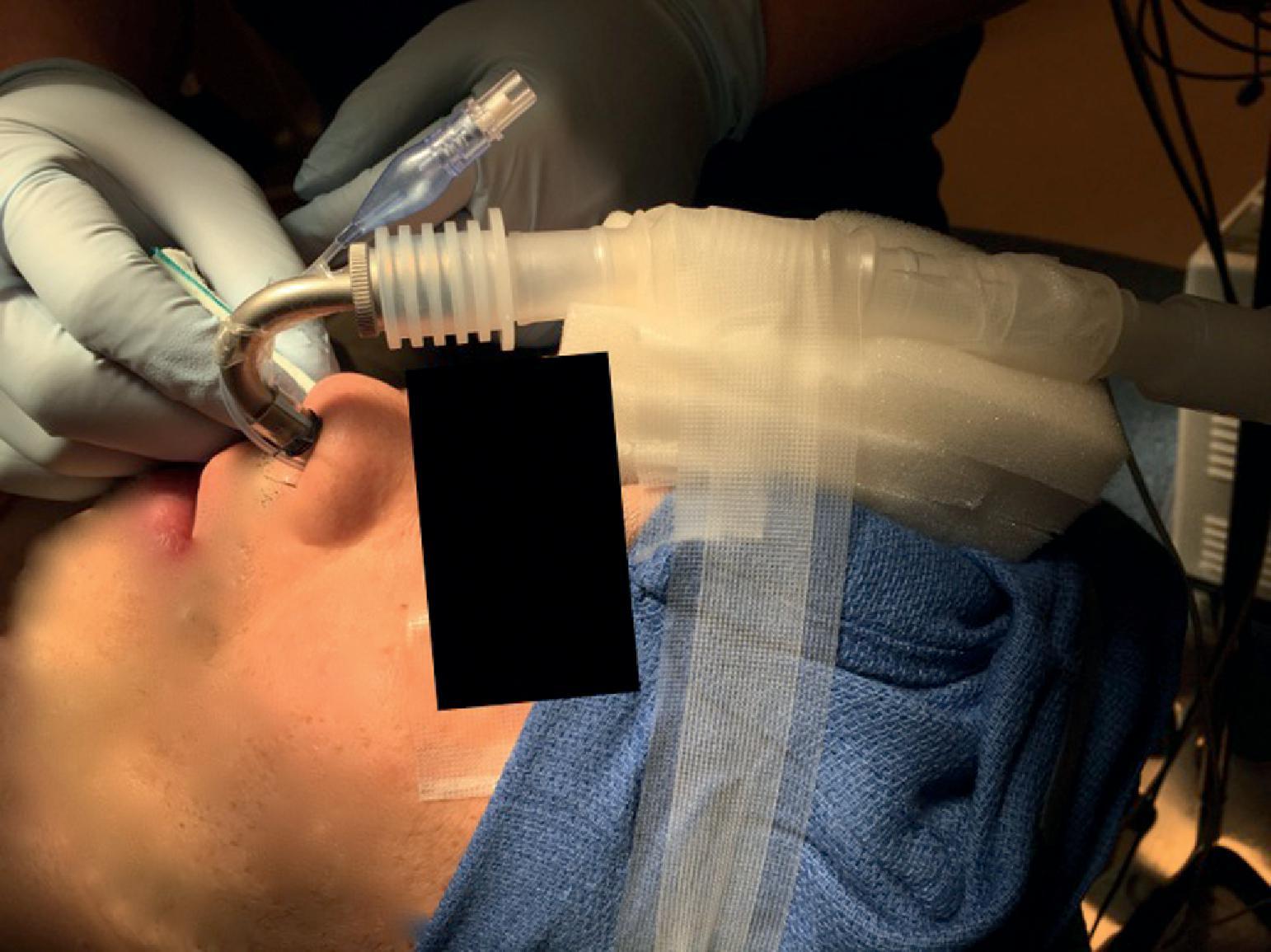
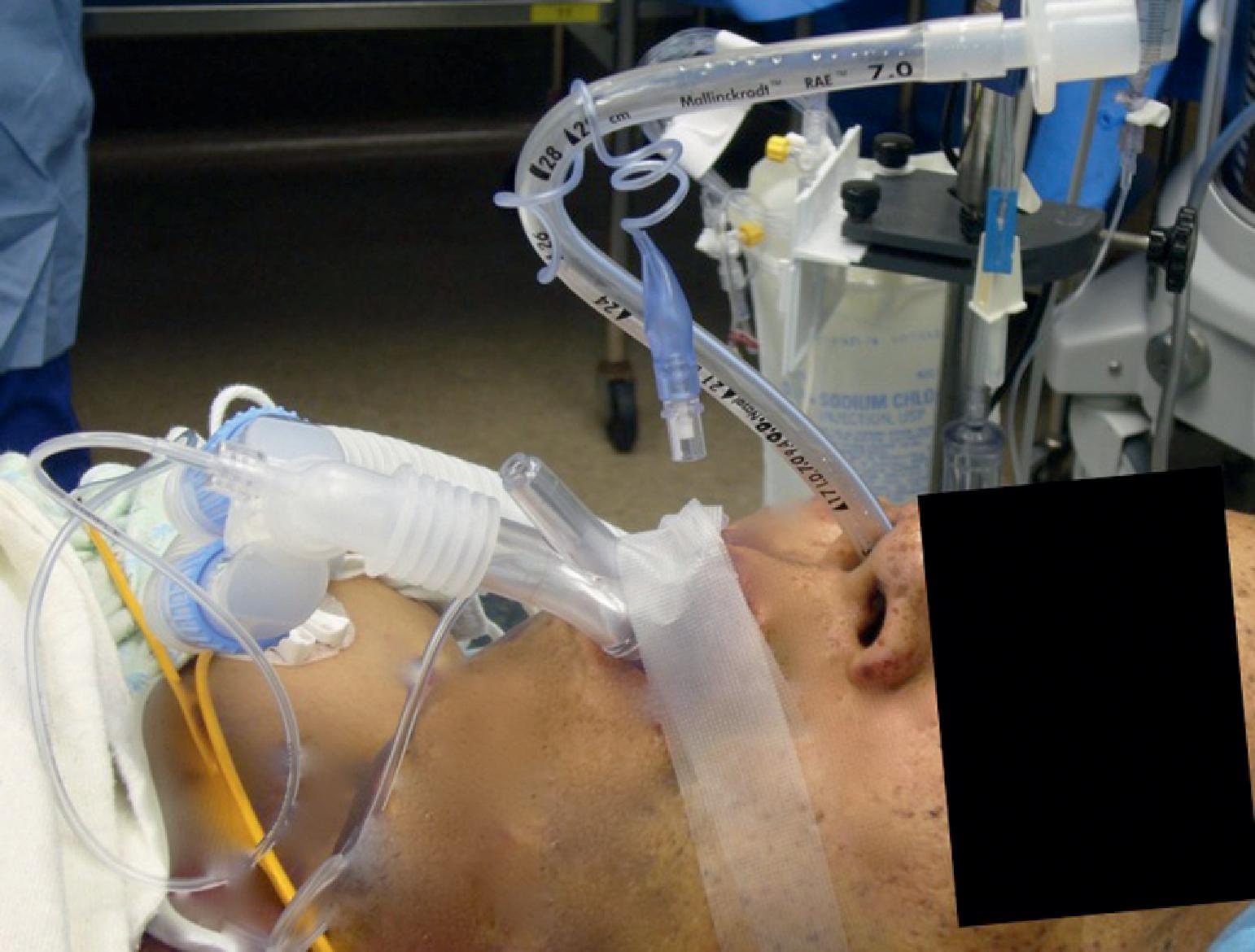
For microlaryngeal surgery, the ETT is usually moved to the left corner of the patient’s mouth to facilitate introduction of the surgical instruments and must be securely taped to the lower jaw, facilitating full opening of the patient’s mouth by the surgeon. The mouth opening and exaggerated full extension of the patient’s neck account for ETT pullback, and a slightly deeper placement of ETT may be recommended in these patients. A small-size ETT, for example, a microlaryngeal tube (MLT) with a 5-mm inner diameter (ID) is routinely used for microlaryngeal surgery ( Fig. 38.4 ), and a nasal intubation with a small-diameter MLT tube (5- to 6-mm ID) is frequently required to facilitate surgical access for TORS. A 6-mm-ID wire-reinforced flexible ETT is frequently preferred for many intraoral procedures.
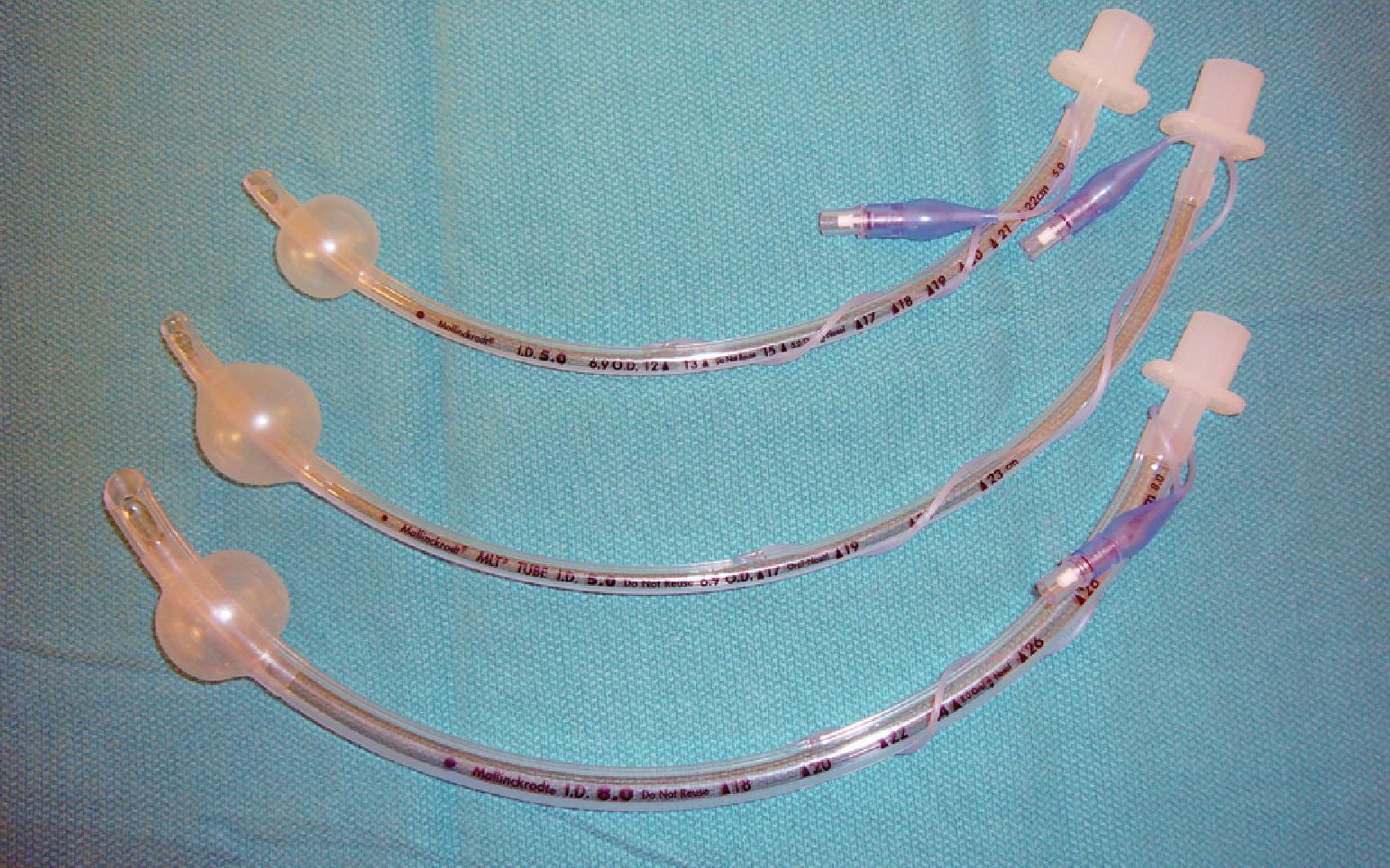
The anesthesia provider must also become thoroughly familiar with the specialized laser and neural integrity monitor (NIM) ETTs and the techniques for their proper placement. Finally, the H&N anesthesia provider should be proficient with jet ventilation (JV) and other intraoperative ventilation techniques used during microlaryngeal surgery (see “ Special Situations / Microlaryngeal Surgery / Jet Ventilation ”).
This chapter focuses on devising safe and effective airway management strategies for patients undergoing H&N surgeries based on best evidence and the authors’ experience. We also discuss some specific techniques and situations deserving special attention.
The preoperative airway assessment must include a comprehensive general medical history, focused history related to upper airway symptoms, a directed general physical and airway examination, a thorough assessment of the previous anesthetic records, details of the surgical plan, and laboratory and imaging studies. The anesthesia provider should step outside the role of an airway proceduralist and try to conduct a joint preoperative patient evaluation with the surgical colleagues for complex H&N cases whenever possible.
The anatomy of H&N is largely noncompliant, and any significant pathologic processes and injuries tend to result in substantial patient suffering and functional impairment. Tobacco and alcohol use are associated with most cases of H&N cancer and predispose these patients to significant comorbidities, such as chronic obstructive pulmonary disease (COPD), hypertension, coronary artery disease, and alcohol withdrawal. Appropriate diagnostic tests are indicated for these patients as part of the preoperative workup and preoperative optimization. Patients with significant lung disease and ventilation/perfusion (V̇/Q̇) mismatch may not be suitable candidates for advanced intraoperative ventilation techniques, such as spontaneous ventilation, apneic intermittent ventilation, JV, transnasal humidified rapid-insufflation ventilatory exchange (THRIVE) or SponTaneous Respiration using IntraVEnous anaesthesia and Hi-flow nasal oxygen (STRIVE Hi). It is not uncommon for H&N cancer patients to present with chronic anemia. Appropriate laboratory studies must be obtained, and electrolyte and fluid status of these patients should be optimized preoperatively. Patients with chronic alcohol consumption require preoperative evaluation of liver function and coagulation status.
Some patients may present with increased aspiration risk, complicating DA management. Lower cranial nerve involvement (cranial nerves XI, X, and XII) may lead to airway difficulty related to aspiration or obstruction. Almost one-half of the patients presenting with laryngeal and voice disorders have silent laryngopharyngeal reflux as the primary cause or as a significant etiologic factor. , Coexistent significant glottic insufficiency (e.g., VC paralysis) may place these patients at increased risk for aspiration of gastric contents. , This can usually be diagnosed during a routine preoperative flexible scope laryngoscopy or laryngostroboscopy performed by the surgeon. Those presenting for esophagoscopy for evaluation and treatment of esophageal obstructing lesions, achalasia, Zenker diverticulum, active gastrointestinal bleeding, or esophageal foreign body removal constitute another category of patients at high risk for aspiration. Even when gastroesophageal reflux disease (GERD) is not clinically significant, adequate preoperative pharmacologic control of the symptoms is warranted: The combination of acid exposure and direct trauma from the operating procedure and TI can lead to laryngeal mucosal injury.
Many patients presenting for H&N surgery are ≥60 years old and will demonstrate high incidence of undiagnosed sleep-disordered breathing and OSA. The nature of many H&N diseases, the presence of craniofacial abnormalities (e.g., retrognathia, macroglossia), male sex, and a history of excessive alcohol intake must also increase the anesthesia provider’s level of suspicion for OSA. A variety of bedside screening tools (e.g., the snoring, tiredness, observed apnea, high blood pressure, body mass index, age, neck circumference, and male gender [STOP-Bang] questionnaire) can be used to identify patients at highest risk for OSA.
Information about previous H&N surgical procedures and radiation therapy, as well as the history of anesthetic and airway management problems, must be obtained and communicated. History of previous difficult TI is one of the most important predictors of anticipated airway management difficulties, yet it is still taken lightly in anesthesia practice.
The history of prior H&N radiation therapy must be elucidated because exposure to radiation therapy frequently makes TI difficult. The radiation-induced tissue fibrosis results in loss of tissue compliance, frequently leads to long-standing glottic and epiglottic edema as a result of impaired lymphatic drainage, and may also restrict the patient’s mouth opening and neck extension.
A systematic and comprehensive preoperative airway assessment is paramount, and the American Society of Anesthesiologists (ASA) 11-point bedside airway assessment tool is a good start. However, standard airway assessment tests are poorly predictive, do not account for aspiration risk and lower airway problems, and fail to assess the severity of upper airway disease and BOT pathology (e.g., epiglottic cancer, epiglottic and vallecula cysts, lingual tonsillar hypertrophy) ( Fig. 38.5 ). ,
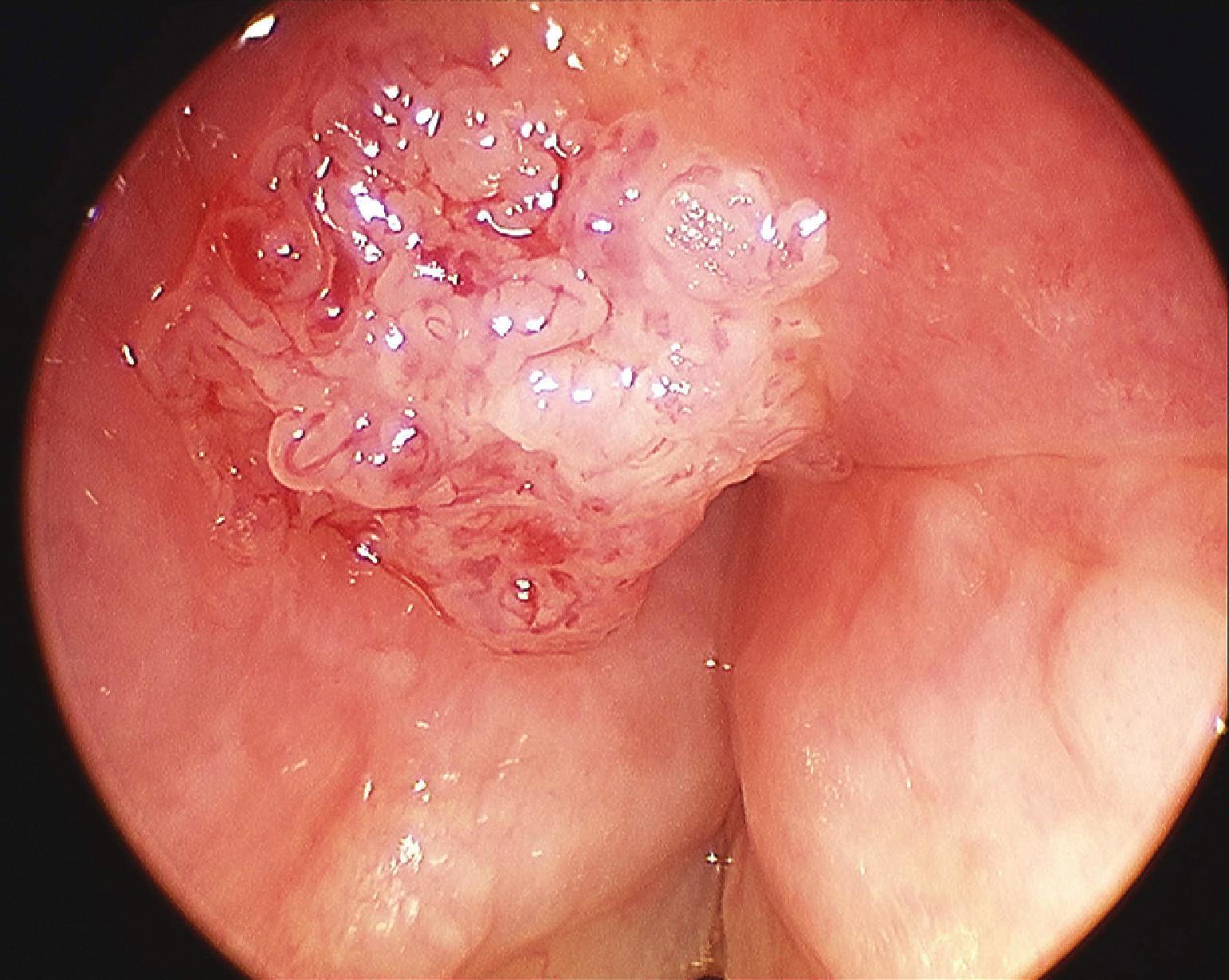
Postradiation changes in the neck and decreased mandibular protrusion are important factors predicting the risk of impossible mask ventilation, difficult mask ventilation, and difficult DL in patients at risk for these conditions (see Chapter 9 ). The reduced submandibular compliance attributed to cancerous involvement, masses, inflammation, or previous radiation therapy ( Fig. 38.6 ) may severely diminish pharyngeal space and restrict tongue displacement during DL, resulting in difficult or failed TI.
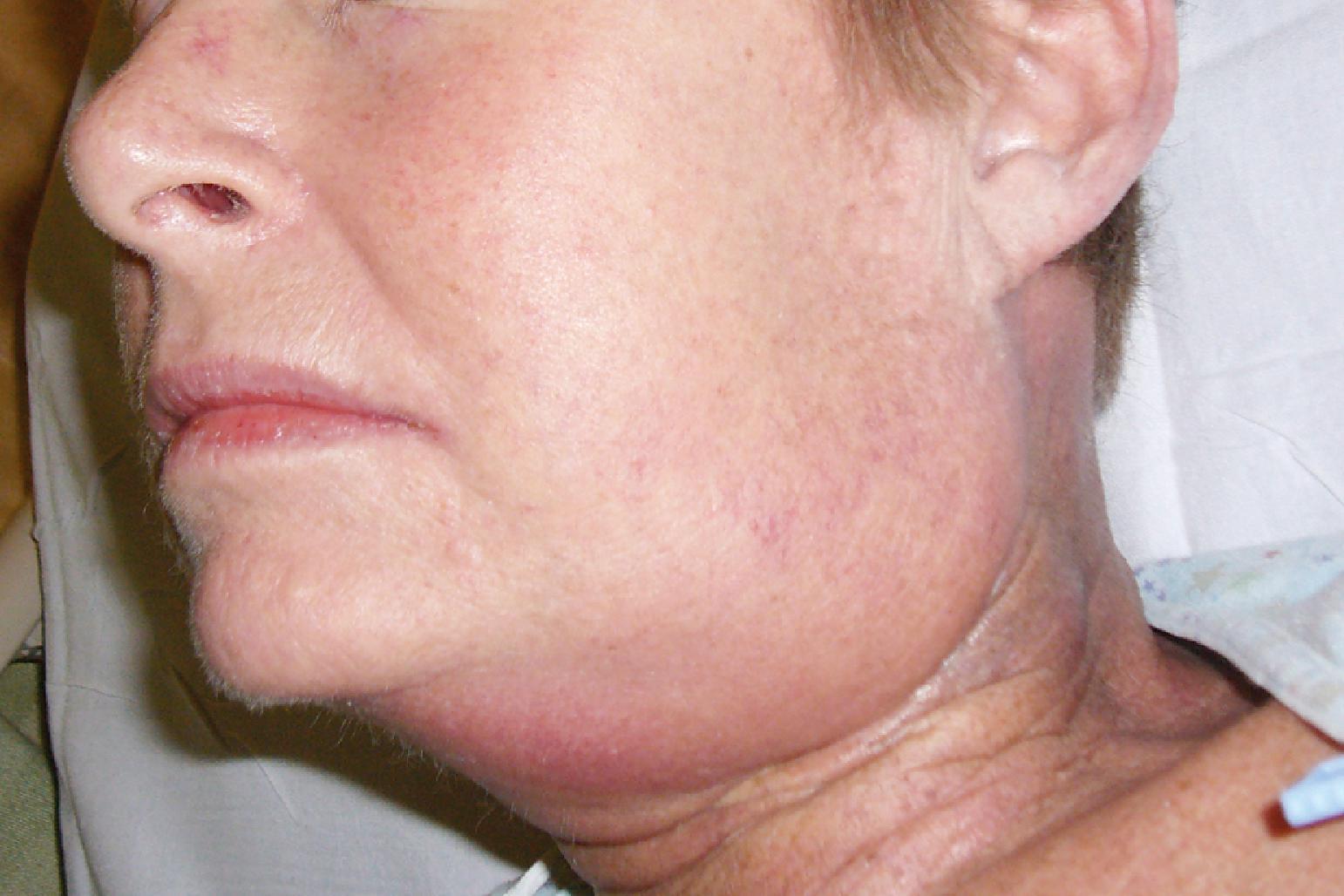
Pharyngeal restriction can be further accentuated by a large tongue or intraoral masses, which can be exophytic and mobile. Common symptoms of airway obstruction may include dyspnea at rest or on exertion, voice changes, dysphagia, stridor, and cough. Voice changes provide an early suggestion of the anatomic level, severity, and progression of the lesion. A muffled voice may indicate supraglottic disease, whereas glottic lesions often result in a coarse, scratchy voice. Physical findings may include hoarseness, agitation, and intercostal, suprasternal, and supraclavicular retraction.
Drooling, dysphagia, and expiratory snoring are the signs of marked pharyngeal restriction, , but inspiratory stridor at rest represents the most worrisome sign, suggesting a reduction in airway diameter at the supraglottic, periglottic, or glottic level of at least 50% (see “ Special Considerations ”/“ Partially Obstructed Airway ”). , Airway compromise in H&N patients may also involve the lower airways. Airway narrowing at the tracheal or tracheobronchial level is typically characterized by expiratory stridor, whereas biphasic inspiratory-expiratory stridor usually points to obstructive subglottic disease. In some cases, preoperative examination of the flow-volume loops may be helpful.
It is prudent to assess the laryngeal mobility, the degree of tracheal deviation, and the location of the cricothyroid membrane (CTM) preoperatively. Significant tracheal deviation, especially in combination with the fixed hemilarynx ( Fig. 38.7 ) and poor or absent visualization of VC during preoperative nasal endoscopy, can be an ominous sign , and may warrant a performance of an awake tracheostomy (see “ Devising Safe Airway Management Strategies for Tracheal Intubation ”/ “ Surgical Airway as a Primary Approach to Tracheal Intubation ” and “ Special Situations ”/“ Partially Obstructed Airway ”).
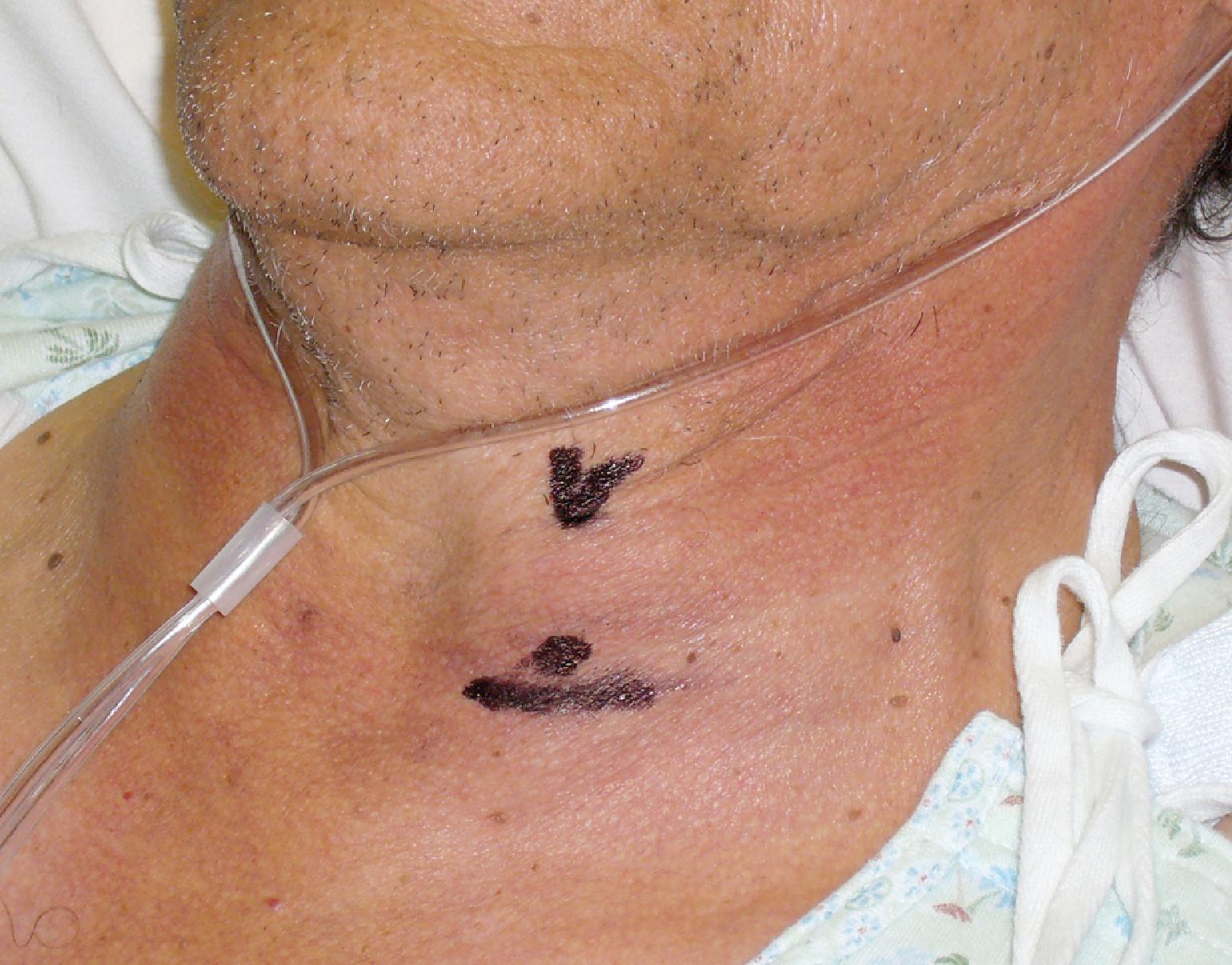
Usually, the extent of disease in elective cases has been comprehensively evaluated preoperatively by routine chest radiography, computed tomography (CT), magnetic resonance imaging (MRI), and flexible laryngoscopy (nasal endoscopy), providing the anesthesia provider with valuable information regarding the location, size, spread, and vascularity of the obstructive lesions; the degree of obstruction; the mobility of the vocal cords; and the extent of laryngeal and tracheal deviation or compression. , ,
Patients with H&N cancer are at increased risk for CICO, and if symptoms of airway obstruction are present, airway imaging and nasal endoscopy are considered a minimum necessary level of investigation for assessing airway management options. , The anesthesia provider must be thoroughly familiar with the results of these studies, and they should be reviewed and discussed jointly with the surgeon.
Preoperative nasal endoscopy is usually performed by the H&N surgeon, but with sufficient practice it can be quickly and effectively executed by the anesthesia provider (preoperative endoscopic airway examination [PEAE]) as part of the preoperative assessment. The PEAE (see Chapter 9 ) is a powerful airway assessment tool that provides precise information about upper airway and laryngeal anatomy to formulate appropriate airway management strategies. , Even in urgent situations, PEAE may help with anticipation and planning for a DA (see “ Special Considerations ”/“ Partially Obstructed Airway ”).
Determining the optimal airway management approach depends on the surgery being performed, location of the lesion, patient’s symptoms, acuity of the situation, and patient’s tolerance of the procedure. It may also be dictated by the anesthesia provider’s skill set and equipment availability, where the need for improvement exists in both areas.
The recurring theme in the NAP4 report is the need for maintaining close lines of communication with the surgical team before and during the intubation procedure. , Failure to anticipate and plan for problems and to develop safe airway strategies will contribute to failures and increase patients’ morbidity. , An airway strategy can be defined as the predetermined set of sequential plans for managing failure of the previous attempts and for achieving and maintaining adequate ventilation, oxygenation, and protection against aspiration.
The decision to proceed with an awake approach can be very straightforward when significant anatomic distortion is present or the patient’s mouth opening is severely limited. In many cases, however, only a certain degree of difficulty can be expected, and decision-making becomes more complicated. For such patients with undefined risk, an approach to an anticipated DA should follow the framework suggested in the ASA DA algorithm, with special attention directed to predictors of difficult mask ventilation, impossible mask ventilation, and their association with difficult DL and TI (see Chapter 9 ).
The likelihood of difficult supraglottic airway (SGA) ventilation (see Chapter 19 ) and difficult surgical airway access (see Chapter 29 ) must also be considered and evaluated. If the emergency cricothyroidotomy is contemplated as part of the airway strategy, success should not be assumed, and it is best to secure the patient’s airway while awake. If the patient’s airway is marginal, but an awake approach is not feasible, the “airway double setup” is warranted: The CTM should be marked, the patient’s neck should be prepped, and the surgical team must be present for induction as well as ready to perform an emergent cricothyroidotomy or tracheostomy. The placement of the tracheal catheter or cannula through the CTM before induction of anesthesia for passive oxygen insufflation and/or subsequent JV shall also be considered (see “ Devising Safe Airway Management Strategies for Tracheal Intubation ”/“ Oxygenation Strategies and Special Situations ”/“ Partially Obstructed Airway ”). Management of cases that may involve a surgical airway as a rescue technique should always be performed where the appropriate equipment is available, most commonly in the OR. ,
The more complicated the patient’s condition is, the more elaborate airway management strategies should become. Patients with H&N cancer, especially those with supraglottic and glottic tumors or a history of radiation therapy, require the longest intubation times and represent the highest risk for adverse TI outcomes. , , In NAP4, airway management was considered poor in nearly 30% of these cases. , The pertinent preoperative imaging and PEAE findings for these patients must be reviewed and discussed with the surgeon to accurately estimate the degree of pathology and facilitate decision-making.
Given a high incidence of anticipated and encountered DA in H&N patients, it is prudent to reach for video-assisted laryngoscopy (VAL) as a primary TI technique in many cases. The ASA Difficult Airway Task Force recommendation to consider VAL as an initial approach to anticipated DA capitalizes on an extensive body of evidence for both steering and channeled VAL techniques (see Chapter 23 ). , The 2013 survey of the Canadian anesthesia practice also has listed VAL as the top technique to use during difficult TI. For complex patients, and for patients for whom at least some degree of DL difficulty is anticipated, we therefore advocate expanding airway evaluation beyond the ASA recommendations to determine the likelihood of difficult VAL. The first-pass intubation success rate with the acute-angle VAL systems, such as the Glidescope or Storz CMac, may be expected to reach 93% to 96% in the general surgical population. For patients with H&N pathology, and particularly those presenting with intraoral airway masses, inadequate glottic exposure may be observed with increased frequency, even with the use of the hyperangulated VAL blades. Hyman and colleagues have found that VAL fails to obtain an adequate view (Cormack-Lehane grade ≥3) in roughly one-third of these patients, highlighting a significantly increased risk for failed TI and oxygenation in this patient population.
Difficult VAL also may be expected in patients with neck pathology (particularly a scar or a mass), abnormal neck anatomy, decreased cervical spine motion, decreased oral entry, and restricted oropharyngeal space. , , , Choosing a VAL depends on the operator’s experience, but the nature and location of the lesion must be considered. For example, it may be safer to navigate around BOT tumors with a channeled VAL, such as Pentax Airway Scope, whose blade engages under the epiglottis, unlike other devices that typically require the tip of the blade to be placed in the vallecula. On the other hand, the steering technique of VAL with a styleted ETT may be more effective for maneuvering around the intraoral lesions.
Difficulties with VAL notwithstanding, management of the anticipated DA with DL alone remains persistent and alarming practice. By studying over 188,000 patients in the Danish Anesthesia Database, Nørskov and colleagues have shown that half of the patients with anticipated difficult TI and over 40% of high-risk patients with anticipated combined ventilation and TI difficulty were planned to be managed by DL as a primary approach.
A consistent NAP4 finding in patients with H&N pathology was the deterioration of the airway following a single or repeated attempts at DL. The H&N tumors can cause considerable airway distortion and can be friable, leading to bleeding, defragmentation, airway soiling, and rapid edema formation. If DL is chosen as a primary approach to TI, multiple attempts should be avoided in order to avert total airway obstruction and CICO situation. , ,
Should DL fail, the rescue with operative laryngoscopy using the anterior commissure scope or with the rigid bronchoscope by the surgeon can be successful. , , The anterior commissure scopes, such as Holinger ( Fig. 38.8 ), are very effective in handling poor laryngeal exposure or glottic obstruction and can be used as a conduit for TI when the bougie introducer or ETT is passed directly down the lumen ( Fig. 38.9 ). Hillel and colleagues have demonstrated that the use of the anterior commissure scopes by otolaryngologists, who were part of the DA response team (DART), helped secure over 35% of DAs and to decrease the number of emergent cricothyroidotomies nearly in half.
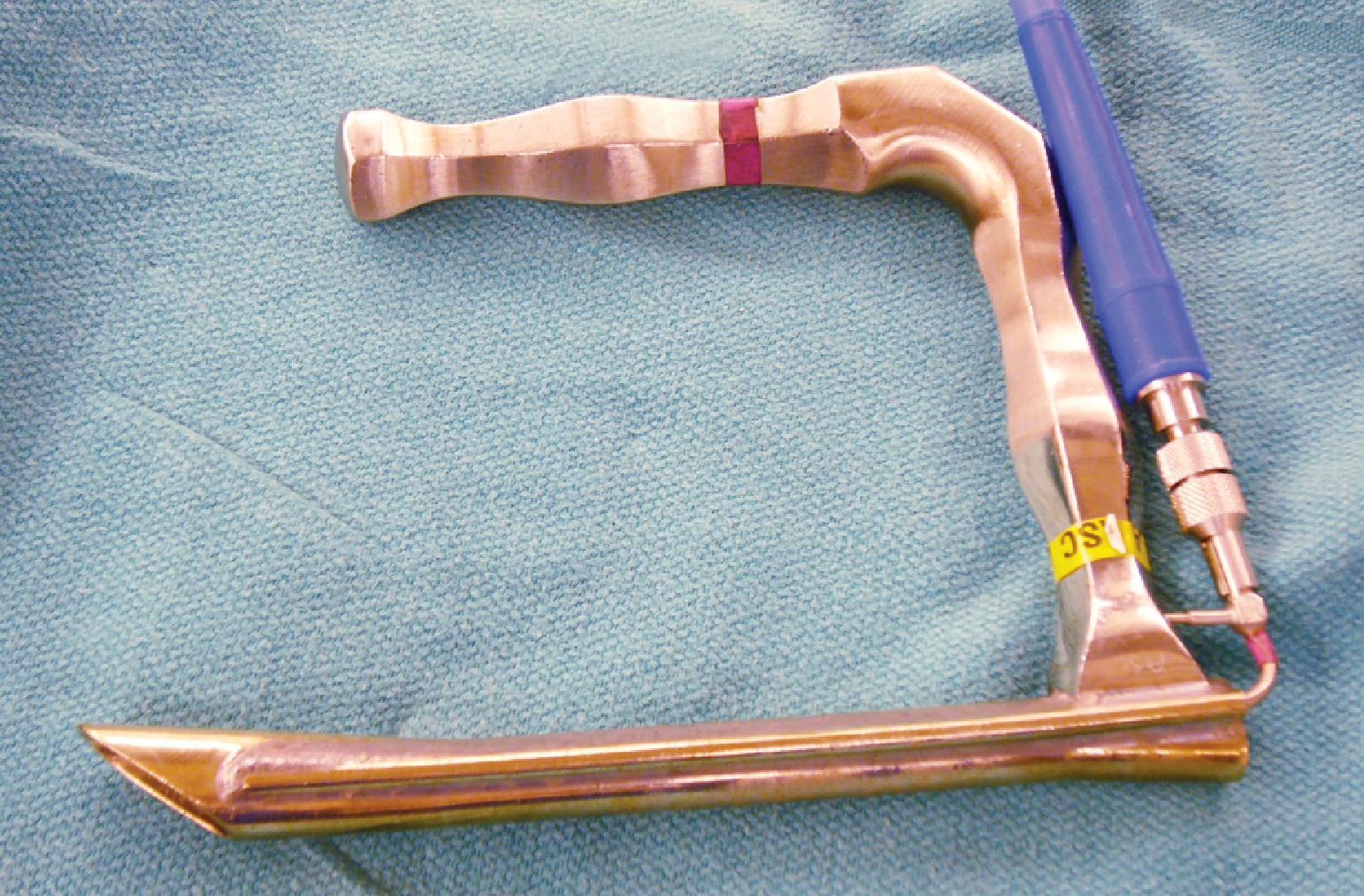
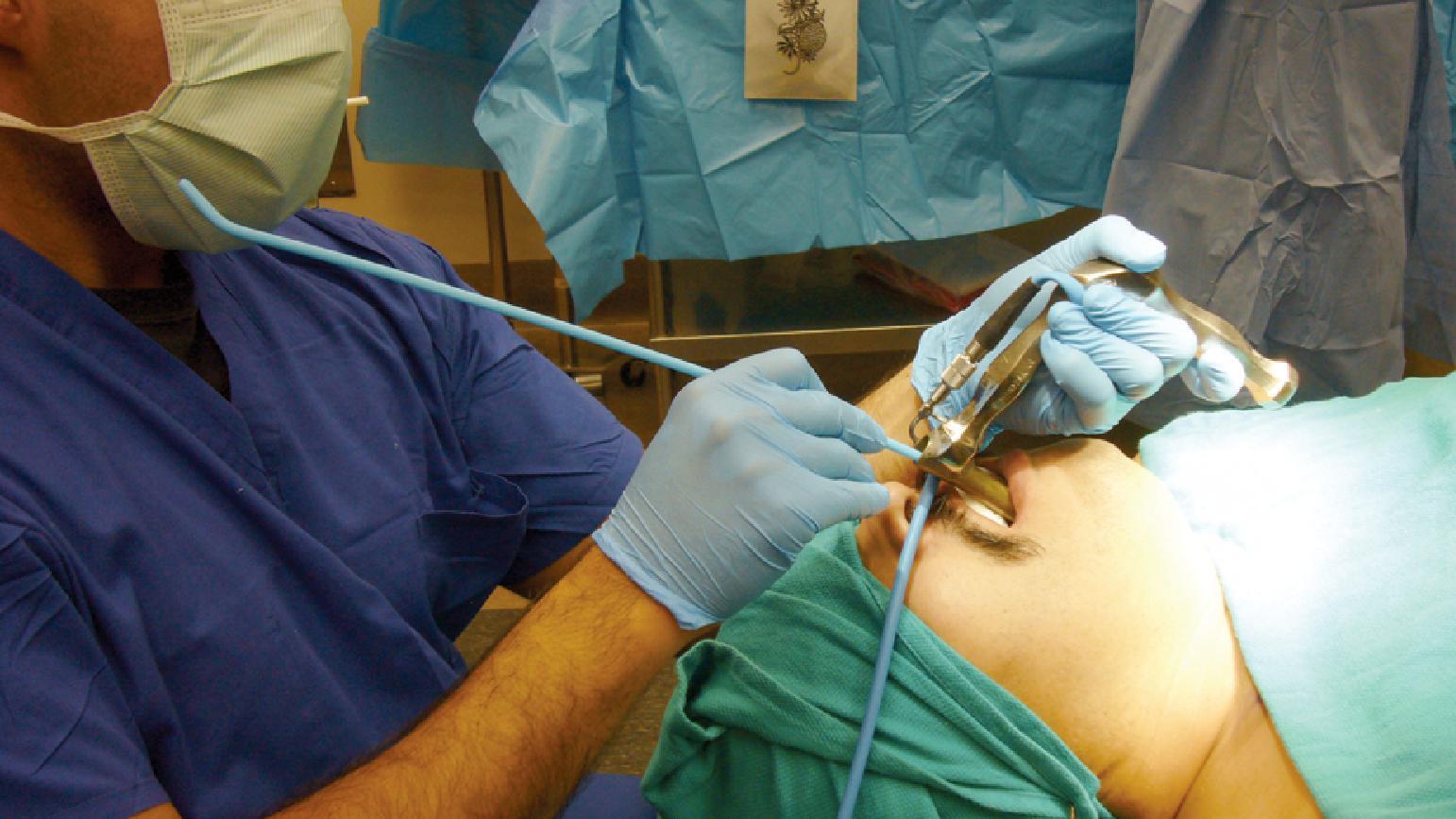
In experienced hands, rigid bronchoscopy can rescue failed TI and CICO situations. It also serves as an indispensable tool for managing acute airway obstruction resulting from foreign bodies, hemoptysis, or tumors. , After the bronchoscope is placed into the patient’s trachea by the surgeon, manual ( Fig. 38.10 ) or JV can commence in a safe manner through the lumen of the bronchoscope. Subsequent airway exchange to ETT can be performed using an airway exchange catheter (AEC) or a gum elastic bougie (GEB) introducer ( Fig. 38.11 ). ,
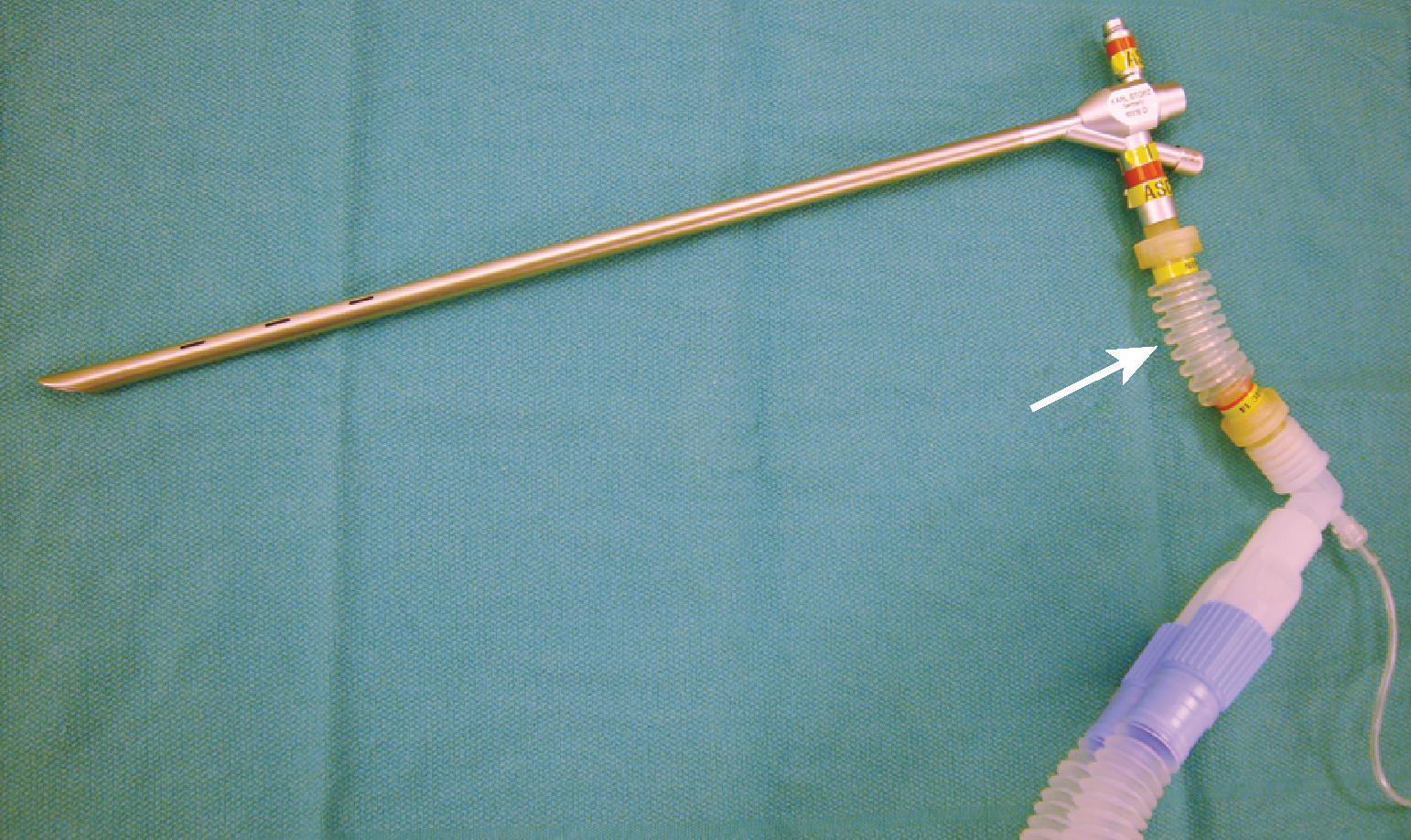
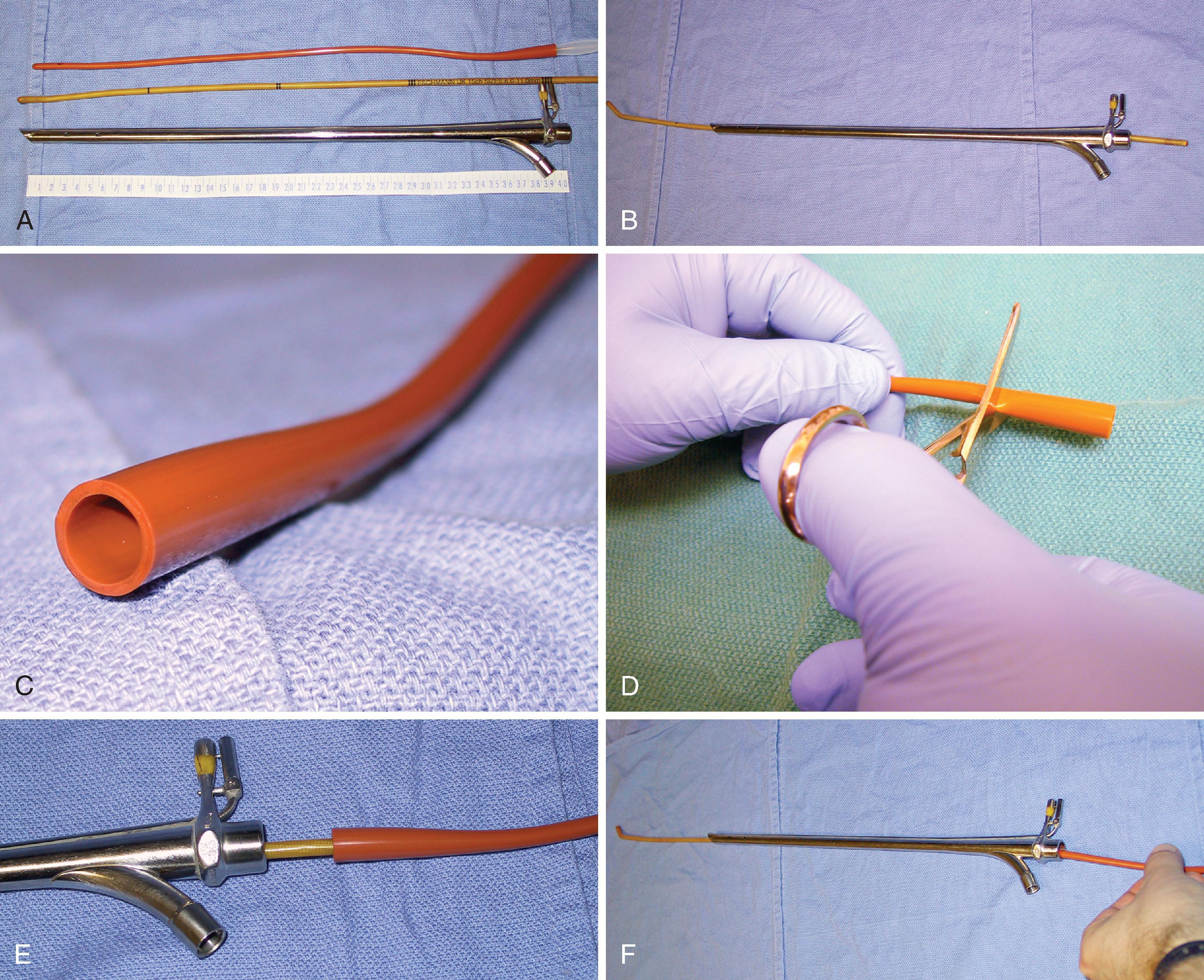
Relying on operative laryngoscopy and rigid bronchoscopy as airway rescue assumes immediate availability of the equipment and expert surgical help. Unfortunately, even in skilled hands quick deployment of these devices can be problematic, especially when unfavorable anatomy precludes full atlanto-occipital extension and establishing the straight line of sight ( Fig. 38.12 ). , , ,
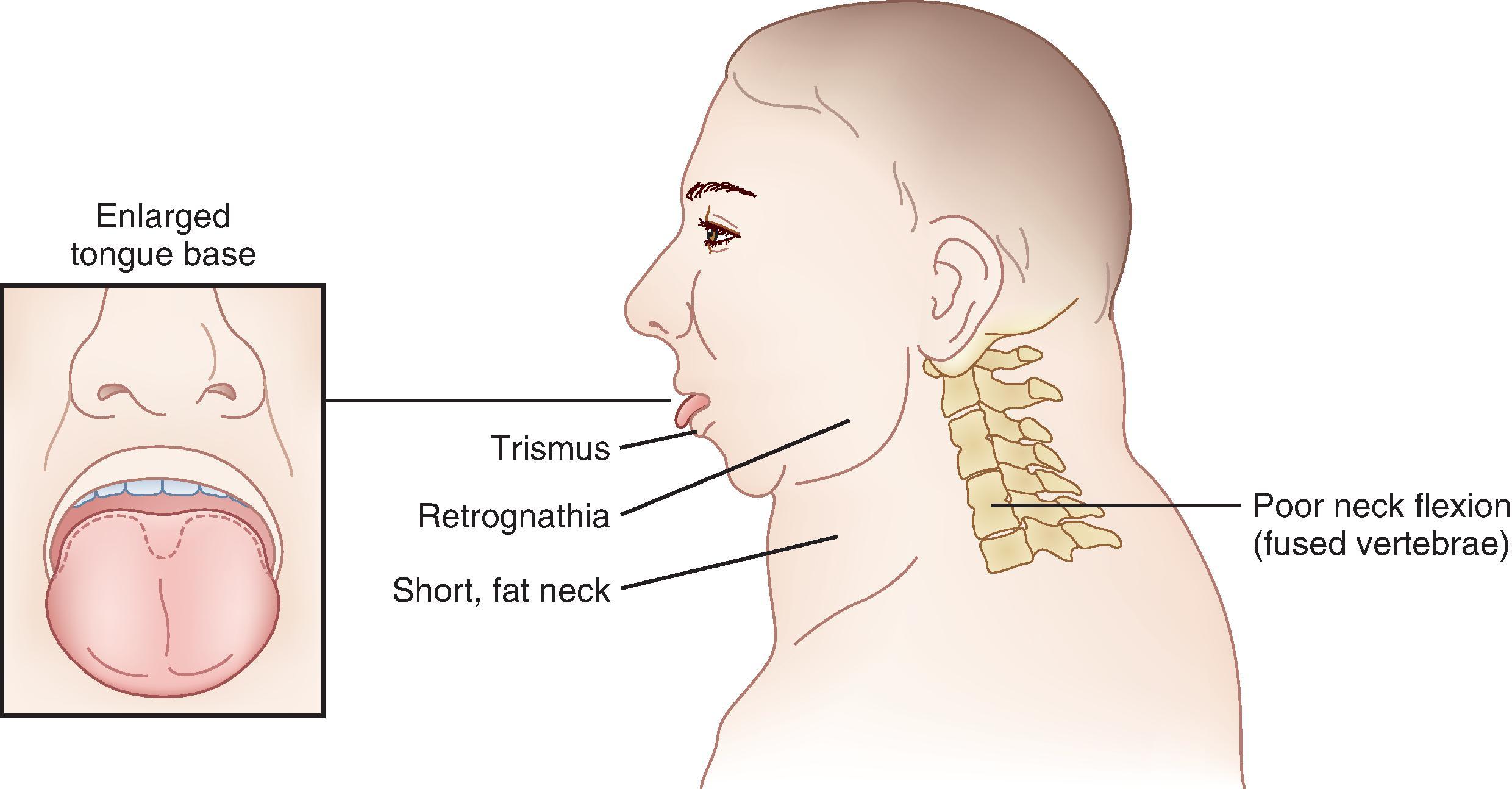
Inhalation induction can be safely used in the presence of noncollapsing lesions, with anticipated failure rate of approximately 5%. Difficulty in maintaining the airway during inhalation induction in patients with large pedunculated tumors, granulomas, and cysts should be anticipated, even if preoperative symptoms of airway obstruction are mild. , Early application of continuous positive airway pressure (CPAP) can help to stent the airway open, but inhalation induction should be considered highly problematic if mask ventilation difficulty is anticipated. In the NAP4 study, inhalation induction failed in 12 of 16 (75%) H&N patients with the compromised airway, and in nearly all these patients (11 of 12) spontaneous ventilation became impossible.
Sevoflurane is the most commonly used inhalation induction agent in adult and pediatric patients. , The minimum alveolar concentration (MAC) of sevoflurane required to provide adequate TI conditions in 50% of unpremedicated adult patients (MAC TI50 ) is 4.5% (95% confidence interval 3.9% to 5.2%), and the 95% effective dose (ED 95 ) for TI is 8%. The time for achieving this ED 95 target in patients with normal airways is approximately 7 minutes, but up to 20 minutes may be required when partial airway obstruction or the preexisting increase in minute ventilation and V̇/Q̇ mismatch are present. , The induction time can be shortened with the addition of small intravenous doses of midazolam or fentanyl , but at the expense of an increased risk of apnea and loss of the airway. Even in patients without severe airway compromise, inhalation induction frequently causes expiratory stridor (25%–40%) and breath holding (7.5%–15%), and the intubating conditions still remain inferior to the use of the neuromuscular blocking (NMB) agents. ,
Overall, if inhalation induction is chosen as the primary approach to the difficult H&N airway, the possibility of failure should be anticipated, and the clear rescue strategies must be in place from the outset.
Recent randomized trials have demonstrated that an awake acute-angle VAL can be as effective as an awake flexible scope intubation (FSI) , ; however, the latter remains the gold standard of care (see Chapter 24 ). It is frequently underused when indicated, probably because of a lack of confidence, skills, judgment, and equipment.
Patients with H&N pathology may require awake FSI more frequently due to common occurrence and/or coexistence of H&N cancer, previous surgery, history of radiation, associated OSA, obesity, and anatomic characteristics, such as reduced mouth opening, limited neck extension, and progressive airway compromise. Both awake and asleep FSI can fail frequently in H&N patients: In NAP4, such failure was observed in nearly 61% of these cases. When performed by designated H&N anesthesia providers, a much lower yet still sufficiently high failure rate of 8.8% may be expected. In the mixed surgical population with anticipated DA, the awake FSI may be expected to fail in 1% to 4% of cases, , , usually without associated severe adverse effects.
The most common reasons for awake FSI failure appear to be the inability to either identify the glottis or to pass the flexible intubation scope (FIS) or ETT. Additional reasons for the failure of asleep FSI include repeated TI attempts, bleeding, and airway obstruction. Previous reports also documented a mere 50% success rate of FSI after repeated DL attempts, and awake FSI should be chosen over an asleep approach in H&N patients whenever possible. ,
The awake FSI requires a high degree of skill yet can be challenging even with proper patient preparation and cooperation. Similar to the inhalation induction strategy, the failure of either awake or asleep FSI should be anticipated in patients with advanced H&N pathology, and solid backup strategies must be in place before the start of the procedure. ,
The optical intubation stylets, such as Bonfils, Shikani, SensaScope, and Clarus Video System (see Chapter 22 ), can effectively lead within an ETT to help bypass mobile supraglottic and glottic masses. The FIS may fail in this situation, either because of the inability to displace the tumor or because the ETT simply would not pass. With optical stylets, once the glottis is entered, the ETT will follow the trajectory of the stylet into the patient’s trachea. However, most of the available adult-size optical stylets require the use of an ETT with a minimum ID of 5.5 to 6 mm.
The SGAs are vitally important in ventilation-centered airway management for H&N patients, who have a higher incidence of difficult and failed TI. A wide variety of SGAs are available, but their comparative performance in DA situations in general, and for H&N patients in particular, has not been vigorously investigated.
By prospectively studying over 20,000 general surgical patients, Parmet and colleagues documented a 94% success rate for rescue ventilation with the classic laryngeal mask airway (cLMA) in unanticipated DA. The successful placement of cLMA and other types of LMA devices in patients with an abnormal airway and/or DA is probably independent of factors used to predict or score difficult TI. , However, reliable SGA ventilation in many H&N patients can be problematic because of difficulties associated with SGA insertion (e.g., restricted mouth opening), with achieving its proper positioning (e.g., space-occupying lesions, previous radiation therapy), and/or with maintaining an adequate airway seal pressure (ASP) and SGA ventilatory capability (e.g., obstructing pathology either at or below VC).
The NAP4 study has demonstrated a high failure rate of the first-generation SGAs and numerous cases of aspiration of gastric contents. Should the use of SGA be required in an H&N patient, it is prudent to reach for the second-generation SGAs with greater ventilation capability and gastric access, such as the LMA Proseal or LMA Supreme. These devices will provide superior ASP and better airway protection and will allow for a quick and reliable detection of device malposition.
It may be reasonable to anticipate a 3.8% to 5.2% failure rate with the second-generation SGAs. To minimize failures in H&N patients, we recommend the GEB-assisted insertion technique, to maximize the first-pass success (FPS) rate, and to ensure optimal esophageal and laryngeal seals. The PEAE can be highly informative in determining the feasibility of SGA placement in H&N patients after the induction of general anesthesia (see Fig. 38.13 and the illustrative case report in Box 38.2 ).
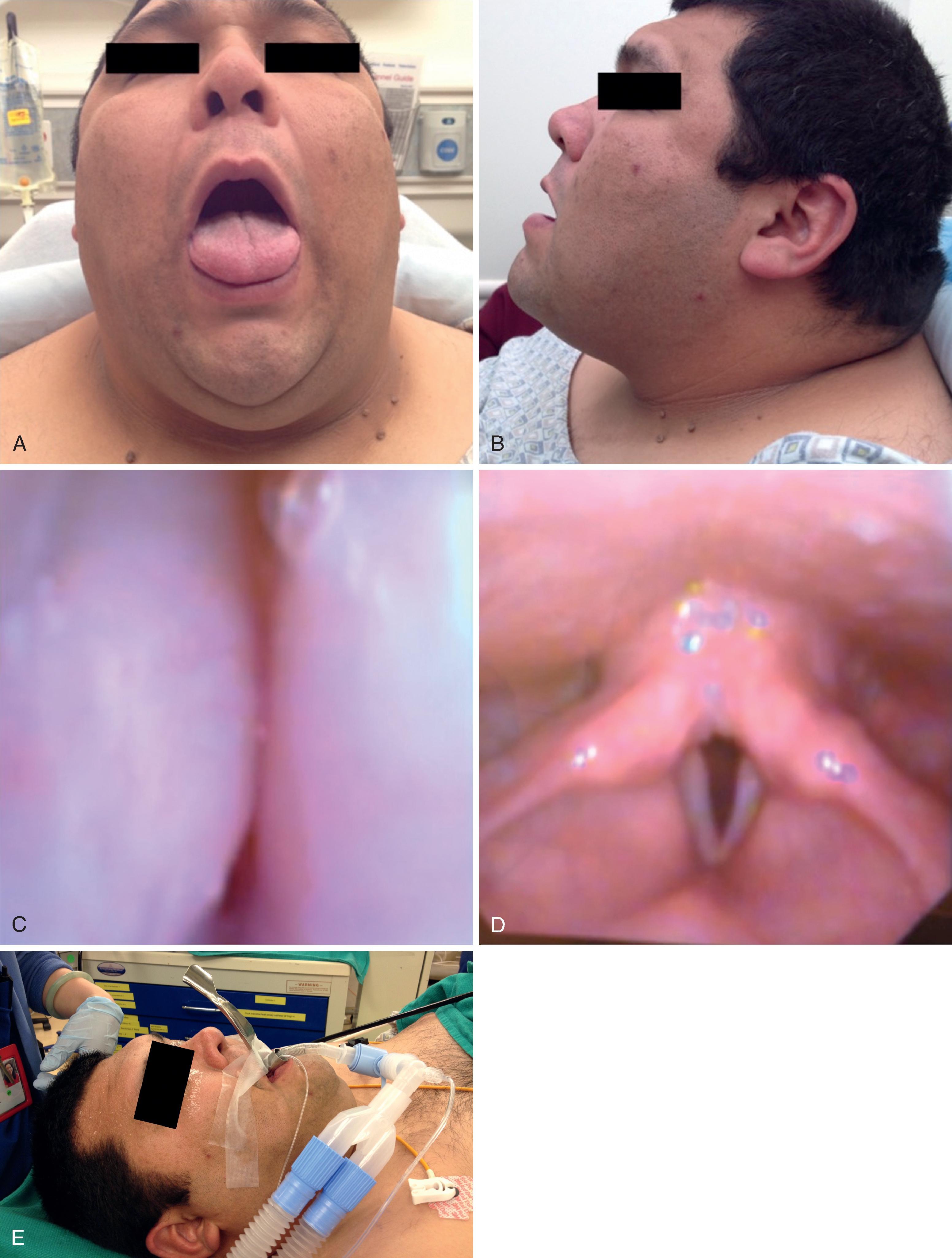
A 38-year-old male with a history of severe obstructive sleep apnea (OSA; apnea-hypopnea index of 115/h, nadir nocturnal SpO 2 56%) and morbid obesity ([MO]; body mass index 63.4 kg/m 2 , SpO 2 93% on room air) presented for elective tonsillectomy. Pertinent airway examination demonstrated multiple risk factors for both difficult and impossible mask ventilation (DMV, IMV) and difficult direct laryngoscopy (DL), such as male sex, Mallampati class IV airway, MO, OSA, a short, thick neck (neck circumference 58.4 cm), decreased atlanto-occipital extension, and reduced mandibular protrusion ( Figs. 38.13A and B ). The awake flexible flexible scope intubation (FSI) was strongly considered, but the patient refused.
With the patient’s consent, preoperative endoscopic airway examination (PEAE) was performed in the operating room (OR) after application of 2 mL 4% lidocaine to the right nostril. The PEAE revealed significantly enlarged “kissing” tonsils and a greatly diminished pharyngeal space, but a clear, normal posterior airway and absent laryngeal pathology ( Figs. 38.13C and D ). These findings were reassuring for developing a primary strategy for using LMA Fastrach (intubating LMA, iLMA) for both ventilation and as a bridge for FOI after induction of general anesthesia.
After adequate preoxygenation and uneventful induction of general anesthesia, iLMA #5 was placed and provided adequate ventilatory control with minimal leak fraction, V T 650 mL, SpO 2 of 98%, and EtCO 2 less than 40 mm Hg. Tracheal intubation (TI) with the manufacturer-supplied 7-mm-ID wire-reinforced ETT was subsequently performed using flexible scope without complications ( Fig. 38.13E ).
The surgery proceeded uneventfully, and TI was accomplished over the Cook Airway Exchange Catheter (CAEC). During the extubation trial, CAEC had served as a bridge for oxygenation and possible reintubation (see “ Tracheal Extubation in Head and Neck Surgery ”). After observing the patient for 15 min in the OR, the CAEC was removed from the patient’s trachea, with the patient fully awake and able to maintain a clear airway.
The PEAE is a minimally invasive technique that can provide highly valuable information about the upper airway in an awake patient.
The presented case illustrates the essential role of PEAE in helping to formulate optimal airway management strategies in patients with anticipated difficult airway. With awake FOI precluded by patient refusal, PEAE provided critical information about the posterior airway that was reassuring for elective supraglottic airway (SGA) placement. Therefore, we were able to proceed with SGA use as our primary strategy for ventilation and as a conduit for FOI.
In an unlikely event of iLMA failure, secondary strategies for airway management included reverting to mask ventilation (MV), placing the LMA Proseal for ventilation and as a bridge for TI using the Aintree airway catheter, and TI using video laryngoscopy.
The PEAE is an invaluable tool in the management of the anticipated difficult airway and can facilitate decision-making about the feasibility of the SGA placement after induction of general anesthesia. Critical anatomic information can be obtained quickly and reliably, and we encourage incorporating this minimally invasive technique into the anesthesia provider’s armamentarium.
The LMA Fastrach (intubating laryngeal mask airway [iLMA]) represents another excellent SGA choice. It has an outstanding ventilatory capability and provides a 92% to 94% success rate of blind TI in patients with anticipated DAs. , In patients with glottic or infraglottic pathology, blind TI intubation should be superseded by FSI-guided iLMA-ETT exchange, which can be performed with or without the use of the Aintree intubation catheter (AIC) (see Chapter 19 ).
The FIS-guided SGA-ETT exchange can be considered one of the core techniques in DA management. It offers the advantage of direct visualization of the laryngeal structures, carries minimal risk of intubation trauma and esophageal intubation, and allows the practitioner to ventilate the patient’s lungs while performing TI. Such an exchange should be considered when DA is encountered, when SGA can easily be displaced, or when airway edema is present or anticipated. , Proceeding with the suboptimally functioning SGA as a stand-alone airway is not acceptable.
The FIS-guided cLMA-AIC exchange technique may be 96% to 100% effective in patients with anticipated DA. , It worked very well in NAP4 for H&N patients with different pathology, including vertebral body fracture, hematoma, pharyngeal edema, and pharyngeal bleeding. The AIC technical characteristics (4.7-mm ID, 6.5-mm OD) should be kept in mind for selecting the appropriately small FIS and ETT of 7-mm or more ID.
Despite a simple concept, the SGA-ETT exchange can fail either as a result of inability to establish the endoscopic view or the dislodgment of the AIC from the patient’s trachea. It can also cause serious complications, such as perforation of the distal tracheobronchial tree because of accidental subcarinal advancement of the AIC during the exchange. The important prerequisite for success is the anesthesia provider’s knowledge of the “anatomy” of the chosen SGA device and the ability to establish the landmark endoscopic view as illustrated for the LMA family of devices ( Fig. 38.14 ). Once such a view is established, the exchange can usually proceed unhampered.

We recommend first practicing on a manikin the details of the SGA-ETT exchange for the LMAs and other mainstream SGA devices, such as i-gel, air-Q (Cookgas intubating laryngeal airway [ILA]), and laryngeal tubes (LT-D, LTS-D), in order to develop the necessary dexterity and appreciation for the important details.
The tubular SGAs, such as the Combitube and the laryngeal tubes (LT), are especially beneficial in patients with limited access to the airway and massive upper airway bleeding or regurgitation, when rapid control of the airway is necessary. Ventilation through the Combitube can be effective when other SGAs (e.g., LMA) have failed. Winterhalter and colleagues have documented successful LT ventilation in 95% of patients with oropharyngeal cancer. Nevertheless, the tubular SGAs cannot be considered fail-safe devices, particularly when an infraglottic obstruction is present.
A combined use of VAL with FIS or optical stylet is gaining increased attention and popularity in complex airway management (see Chapter 25 ). The VAL facilitates FIS/optical stylet maneuvering when the anatomy is severely distorted or supraglottic/glottic tumors are present and allows for continuous observation of the intubation procedure and ETT advancement both from above and below the vocal cords, with diminished risk of tumor disturbance (see Fig. 38.15 and illustrated case report in Box 38.3 .).
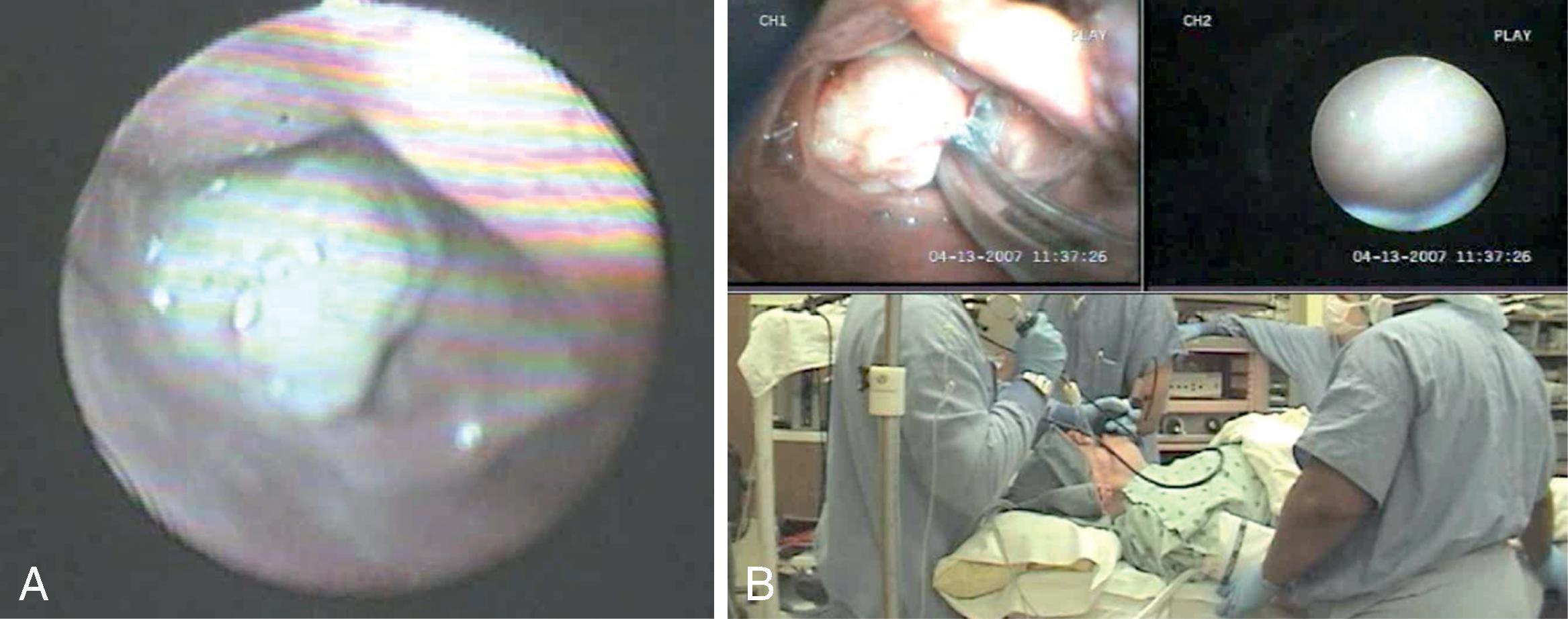
A 79-year-old male with mobile, fungating T2N0 squamous cell carcinoma of the left vocal cord involving perilaryngeal tissues presented with progressive shortness of breath and diminished exercise tolerance. The patient had minimal inspiratory stridor because he was able to self-regulate the rate and depth of breathing to reduce the degree of dynamic airway obstruction. There was no tracheal extension of the tumor, and the patient’s past medical history was otherwise noncontributory.
Examination of the patient’s airway revealed a Mallampati class 2 airway, normal thyromental distance, and full range of neck motion. Neck was without visible distortion or palpable masses, and the cricothyroid membrane was easily identifiable.
Preoperative discussion with the surgeon regarding airway management and surgical plan addressed the potential for an awake tracheostomy, and possible laryngectomy, should the tumor be found to deeply invade the larynx and laryngeal cartilages. Alternatively, should the tumor be removed superficially, laryngectomy could be avoided. The airway management plan was formulated to allow for avoidance of awake tracheostomy and further in-depth surgical evaluation and resection of tumor with the patient anesthetized.
The patient was brought to the operating room and connected to the standard monitors. Preoperative endoscopic airway examination (PEAE) revealed that the tumor was attached to the left vocal cord and pivoted anteriorly, superiorly, and leftward with spontaneous ventilation, producing a ball valve phenomenon. It was determined from this examination that the larynx and trachea could be successfully exposed and navigated with an endoscopic approach from an inferior-right approach to the larynx and tumor (toward the 5 o’clock direction, Fig. 38.15A ).
Because of the size, motion, and lack of view of the larynx on PEAE, a combined intubation approach was chosen using two video-enabled endoscopes: the Glidescope video-assisted laryngoscope (GVL) and the Shikani Optical Stylet (SOS). With adequate upper airway topicalization and moderate sedation, the GVL was used to expose the epiglottis and tumor, and the SOS was introduced at the 5 o’clock position to the tumor, navigating the mass with the optical stylet positioned inside the 6-mm-ID ETT ( Fig. 38.15B ). Upon passing the mass, the interior of the laryngeal cartilage was visualized with the SOS video channel, and the tracheal tube was easily advanced off the stylet without resistance.
The surgery proceeded uneventfully, and the tracheostomy was avoided. A staged extubation using a Bailey maneuver (see “ Tracheal Extubation in Head and Neck Surgery ”) was performed with an air-Q size 4.5 before emergence. Upon full emergence from anesthesia and ensuring adequate ventilation, the patient’s airway was suctioned and the air-Q supraglottic airway was removed. The patient regained consciousness and awareness to such an extent that he was able to move himself over to the transport cart with minimal assistance.
Postoperatively, the patient had undergone chemotherapy and radiation therapy, with excellent results. At 4-year follow-up, he continued to be disease free, with some long-standing benign mild erythema of the left vocal cord.
The presented case illustrates a careful, stepwise approach to airway management of a patient with the partially obstructed airway and the value of PEAE in developing optimal intubation strategy (see “ Preoperative Airway Assessment and Preparation ”/“ Endoscopy and Imaging Studies ,” and “ Special Situations ”/“ Partially Obstructed Airway ”). Patients with glottic lesions present increased challenges to the anesthesia provider, and the intubation approach should maximize the laryngeal exposure.
The combined video intubation techniques can be highly effective in these patients because they allow a continuous visualization of the intubation procedure both from above and below the lesion, minimizing the chance of tumor disturbance. With video-assisted laryngoscopy–enabled wide laryngeal exposure, the optical intubation stylets can lead within ETT to help bypass mobile masses. Once the glottis is entered, the ETT will follow the trajectory of the stylet into the patient’s trachea.
Maintaining spontaneous ventilation in these patients provides a superior margin of safety. An awake flexible scope intubation may fail with the obstructing glottic lesions, either because of the inability to displace the tumor or because the ETT simply would not pass. A forceful advancement of the ETT off the flexbile scope may cause tumor defragmentation, bleeding, and contamination of the lower airway.
The combined video techniques will likely continue to play a bigger role in complex airway management of H&N patients. They demand excellent dexterity, which can be achieved with manikin practice in the simulation lab.
In the large prospective study of 140 patients with anticipated DA, Lenhardt and colleagues have shown that a combined VAL-FSI technique increases the success rate of TI in patients with cervical spine pathology who could not be intubated with VAL alone. Cook and colleagues have demonstrated a 100% success rate of TI in patients with anticipated DA when a combination of a channeled VAL (Airtraq) and a flexible dynamic stylet (an introducer or FIS) was used; TI was accomplished in less than 30 seconds in 73% of these patients. Mazzinari and colleagues prospectively studied a combined VAL (Glidescope)-FIS technique in 80 patients with multiple predictors of difficult TI and demonstrated 90% reduction in TI injury, 35% increase in TI FPS, and shorter intubation time.
The combined techniques will likely continue to play a bigger role in complex airway management of H&N patients. They demand excellent dexterity that can be achieved with prior manikin practice in the simulation lab. It should be kept in mind that the VAL-FIS technique requires the presence of two operators, with at least one of them being proficient with FIS.
Oxygenation-centered airway management is critical for H&N patients, who present with the higher incidence of failed TI and a CICO situation. The active oxygenation strategies should be in place throughout the process of DA management and are described in detail in Chapter 15 .
THRIVE improves the patient’s oxygenation during awake FSI. Its use during asleep TI should be strongly considered in H&N patients, as THRIVE prolongs the apneic period, increases peri-intubation Spo 2 , and improves FPS, even in patients with a severely compromised airway. , It is likely that THRIVE will continue to play an even bigger role in DA management and laryngologic surgery in the future, pending adequate validation studies. Placement before induction of anesthesia of a transtracheal jet ventilation (TTJV) catheter for providing tracheal oxygen insufflation or high-frequency TTJV also can be considered in complex cases; proper placement of the catheter should be confirmed by aspirating the tracheal air with the syringe and by capnography. Substituting a TTJV catheter for an Arndt cricothyroidotomy cannula offers the advantage of using its 3-mm-ID lumen with the low-pressure gas source, thus allowing for manual ventilation using the anesthesia circuit or an Ambu bag.
An awake tracheostomy is usually undertaken in patients with significant airway compromise, where postoperatively the caliber of the airway is not expected to improve. The procedure should be performed under local anesthesia, and without sedation in advanced cases. In selected cases, judicious IV sedation may be appropriate, but it should be administered with extreme caution. The decision to proceed with the awake tracheostomy by the surgeon may also be contingent upon the lack of advanced airway skills on the part of the anesthesia provider. Data indicate that when the patient’s airway is managed by dedicated H&N anesthesia providers, the awake tracheostomy can be largely avoided: In a prospective series by Iseli and coworkers, it was required in only 2 of 153 (1.3%) patients.
In advanced cases, awake tracheostomy can prove technically challenging or impossible and will require general anesthesia. There is a clear preference on the part of H&N surgeons to perform a tracheostomy under controlled conditions, after induction of anesthesia, to avoid airway trauma, tumor disturbance, and tracheostomy tube displacement or obstruction. An elective tracheostomy should also be considered if significant postoperative airway compromise is anticipated, if the patient may return to the OR, or after major H&N reconstructive procedures.
An awake dilator cricothyroidotomy also can be safely performed and may serve as a viable alternative to tracheostomy for many H&N patients with a DA. ,
For emergency airway management, surgical cricothyroidotomy is strongly preferred over transcutaneous CTM access; in the NAP4 study, the emergency transcutaneous cannula cricothyroidotomy failed in 60% of H&N patients. , The observed failure was attributed to the inability to place the cannula or to its misplacement, fracture, kinking, blockage, dislodgment, and barotrauma. , These findings highlight the need for training anesthesia providers to perform the surgical airway and for the immediate availability of all the necessary equipment for surgical airway access.
A preformulated extubation strategy should constitute an integral part of DA management and is especially important for H&N patients who are at high risk for extubation failure. , Within the NAP4 cohort, one-third of adverse airway events occurred during emergence and recovery from anesthesia, with airway obstruction being the most common cause.
The comprehensive approach to the extubation of the DA is covered elsewhere (see Chapter 47 ), with detailed framework outlined by the Difficult Airway Society (DAS) Extubation Guidelines and other high-impact publications aimed specifically at H&N patients. The difficulty of the intubation procedure, the extent and duration of the surgery, the degree of postoperative swelling and anticipated airway obstruction, the possibility of postoperative bleeding, and the patient’s state of consciousness on emergence, as well as the patient’s preoperative status, all should play a role in the anesthesia provider’s decision-making. , , Most important, every extubation of an at-risk H&N patient should be considered a possible reintubation, and all the necessary airway equipment and professionals should be in place before the extubation trial starts.
The AEC is most commonly used to provide continuous tracheal access during the extubation trial. The AEC serves as a conduit for oxygen insufflation, JV, reintubation, and a brief suctioning. The practical points of AEC use include never advancing AEC against resistance, confirming proper AEC placement by the ability to jet ventilate before ETT removal, avoiding sucarinal placement (keep AEC at 25–26 cm on the alveolar ridge), and removing AEC only after tracheal position of the new ETT has been confirmed. Refer to Table 38.1 for the technical characteristics of Cook AECs.
| AEC Size | AEC OD (mm) | AEC ID (mm) | AEC Length (cm) | ETT Size |
|---|---|---|---|---|
| 8 Fr | 2.7 | 1.6 | 45 | ≥3.0 |
| 11Fr | 3.7 | 2.3 | 83 | ≥4.0 |
| 14 Fr | 4.7 | 3.0 | 83 | ≥5.0 |
| 19 Fr | 6.3 | 3.4 | 83 | ≥7.0 |
Tracheal extubation of an uncomplicated H&N airway also presents a unique challenge to the anesthesia provider. Smooth emergence from anesthesia, devoid of patient straining, bucking, and coughing, is essential for avoiding the formation of hematoma, disrupting delicate surgical repairs, and minimizing undesired hyperdynamic responses. Extubating the patient’s trachea at a deep plane of anesthesia is problematic in H&N surgery because of the increased risk of postextubation laryngospasm and overall increased need for the airway support and protection required on the part of the anesthesia provider.
Smooth extubation strategies include the use of SGA in lieu of ETT (see “ Use of the Supraglottic Airways as the Primary Ventilatory Devices in Elective Head and Neck Surgery ”), the ETT-SGA exchange at the end of the case (the Bailey maneuver), and a pharmacologic approach that best relies on a low-dose remifentanil infusion to blunt the tracheal responses.
The Bailey maneuver involves, in steps, insertion of SGA (usually, the LMA) behind the existing ETT with the patient still adequately anesthetized, removal of ETT, and administration of ventilatory support through the SGA until the patient resumes spontaneous ventilation and awakens from anesthesia. Remifentanil provides a predictable, rapid, and almost simultaneous recovery of consciousness and protective airway reflexes, while also blunting sympathetic responses associated with extubation. , Current data indicate that EC 95 of effect site concentration of remifentanil for blunting tracheal reflexes after balanced desflurane and sevoflurane anesthesia is 2.3 to 2.9 ng/mL, which corresponds to the manual infusion rate 0.08 to 0.1 µg/kg/min. This is higher than that observed with the total intravenous anesthesia (TIVA), where a target concentration of 2.1 ng/mL and a corresponding manual infusion rate of 0.07 µg/kg/min is usually sufficient. The authors’ experience corroborates that of others indicating that lower blood target concentrations of remifentanil (1.5–2.0 ng/mL and corresponding manual infusion rates of 0.05 to 0.06 µg/kg/min) may be equally effective, especially if TIVA was used. , , , A single IV bolus of lidocaine may help prevent cough at extubation in a dose-dependent manner in the range of 0.5 and 2.0 mg/kg. In our experience, significant dose-response variability makes this approach less reliable compared to IV remifentanil administration. Delayed recovery of consciousness may also be observed with increased frequency with higher IV lidocaine doses given at the end of surgery.
Become a Clinical Tree membership for Full access and enjoy Unlimited articles
If you are a member. Log in here